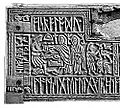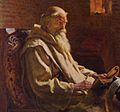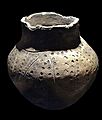Anglo-Saxon mythology facts for kids
Anglo-Saxon mythology refers to the Migration Period Germanic paganism practiced by the English peoples in 5th to 7th century England before conversion to Christianity.
Contents
Origins and history
The Anglo-Saxons, composed of tribes of the Angles, Saxons, Friesian and Jutes, arrived in Britain from southern Scandinavia, the Netherlands and northern Germany. It is from these people that the modern English language (Angle-ish) derives. An impression, but only that, of the Anglo-Saxon mythology can be obtained from reading about Scandinavian mythology. The latter was written down much later, by Snorri Sturluson, because Iceland remained pagan until well into the Christian era (c.1000). The Norse of Iceland and the English certainly shared a common ancestry in 6th century Denmark. The Anglo-Saxons were a largely illiterate society and tales were orally transmitted between groups and tribes by the Anglo-Saxon traveling minstrels, the scops, in the form of verse
The chief literary source is Bede, a Christian monk who wrote of the old English calendar in his De Temporum Ratione. Only a little Old English poetry has survived, and all of it has had Christian editors. The epic poem Beowulf is an important source of Anglo-Saxon pagan poetry and history, but it is clearly addressed to a Christian audience, containing numerous references to the Christian God, and using Christian phrasing and metaphor. The monster Grendel, for example, is described as a descendant of the biblical Cain. In fact, the only fragment of poetry dating to the pagan era that has not undergone edits by Christian editors is the Finnsburgh Fragment.
Beliefs
The Anglo-Saxons believed in supernatural creatures such as elves, dwarves and giants ("Etins") who often brought harm to men. It is likely that they believed in Wyrd (German "werden"), usually translated as "fate," although the modern term fate does little justice to the true meaning of wyrd.
Being a Germanic people, the Anglo-Saxons worshiped the same gods as the Norse and other Germanic peoples. The names are slightly different due to the differences in language among the Germanic peoples. For example, Thunor of the Anglo-Saxons was the same god as Thor of the Norse and Donar of the Germans. Likewise, Woden of the Anglo-Saxons is the same as Odin among the Norse and Wotan of the Germans.
The Gods
| Anglo Saxon | Old German | Norse equivalent |
|---|---|---|
| Wōden | Wodan | Odin |
| Thunor | Donar | Thór |
| Tíw | Zîu | Týr |
| Seaxnéat | Saxnôte | none |
| Géat | Gausus | Gautr |
| *Fríge | Freja | Frigg |
| Éostre | *Ôstara | Possibly Idunn |
| Ing | none | Yngvi-Freyr |
| Baldaeg | Baldere | Baldr |
| Hama | Heime | Heimdallr |
The Ése
The Ése correspond to the Norse Æsir.
Woden, the leader of the Wild Hunt and the one who carries off the dead, is one of the chief gods of the Anglo-Saxons before the Christian era. He was held to be the ancestor of Hengest and Horsa, two legendary figures from early English history and most of the early Anglo-Saxon kings claimed descent from Woden. He gives us the modern Wednesday ("Woden's day").
Thunor, is the god of thunder, who rules the storms and sky. He also protects mankind from the giants. He was the god of the common people within the heathen community. His name gives rise to the modern Thursday ("Thunor's Day").
Fríge is the goddess of love, and is the wife of Woden. She is one of the most powerful Goddesses, this position being threatened only by Freya. Her day is Friday but there is also the belief that Friday is named for Freya instead.
Tiw is the god of warfare and battle, and gives us Tuesday ("Tiu's day"). Some people believe that he is a sky-god figure and formerly the chief god, replaced over the years by Woden.
The Wen
Ingui Fréy was one of the most popular Gods, after Thunor and Woden - there is evidence to suggest that Ingui was the most popular of the Anglo-Saxon deities, his cult later being replaced in popularity by that of the Ese. He is above all the god of fertility, bringing and fruitfulness to the crops, herds, and the folk. Though he is a fertility god, he is also connected to warfare to a degree; however, this warfare is defensive, as opposed to offensive, and is not to create havoc. After all, peace is necessary for a good harvest and a productive community, while needless warfare destroys any prospect of peace and fruitfulness. The Yngling royal line of Sweden claimed descent from him.
Freya, or Freo, is said to be the most beautiful of all the goddesses, and is therefore described as the goddess of love. She is not to be mistaken with Frige, however; Frigga's is love and marriage. It is likely that Freya directed Woden's Waelcyrge onto the battlefield to claim the dead soldiers. Like her brother, Fréy, she is connected to abundance and wealth; however, her wealth is in metals and gems. She is also a goddess of magic, having taught Woden "seithr".
Neorth is Frey and Freya's father, and is the god of the seas and commerce. He is called upon by fishermen and sailors who depend upon good seas. Like his son and daughter, his realm is that of wealth; namely, the wealth of the sea. He married the giantess Sceadu, though the marriage was not successful as neither of them could accept the other's element; Neorth his sea, and Sceadu her mountains.
Other Gods and Heroes
Hengest and Horsa, who are named in historical sources as leaders of the earliest Anglo-Saxon raids and settlements in the south, may also had deific status. The name Hengest means "stallion" and Horsa means "horse"; the horse in the Anglo-Saxon mythology is an important symbol.
Wayland is a mythic smith. Originally, he was an elvish being, a shape-changer like his wife, a swan maiden and Waelcyrge. His picture adorns the Franks Casket, an Anglo-Saxon royal box and was meant there to refer to wealth and partnership.
Eorthe, whose name means "Earth," is the wife of Woden and mother of Thunor. She is also the daughter of the Goddess Niht. Her worship is generally passive, as opposed to active, though she is called on for "might and main." Her latent strength can be seen in her son, Thunor.
Eostre, according to St. Bede, was a Goddess whose feast was celebrated in Spring. Bede asserts that the current Christian festival of Easter took its name from the Goddess's feast in "Eostur-monath" (April/Aprilis).
Niht is the Goddess of Night, and also the mother of Eorthe. The Norse night was the daughter of Narvi. She was married three times; the first to Naglfari by whom she had Aud; the second, to Annar by whom she had Eorthe; and the third to Dellinger Daeg.
Sigel is the Goddess of the Sun. Her day is, of course, Sunday.
Practices
Since Anglo-Saxon religion a subset of Germanic paganism in general, many of its central practices are also shared by other religions such as the religion of the Norse peoples.
- November in Old English was known as blótmónath, as this passage points out:
- "This month is called Novembris in Latin, and in our language the month of sacrifice, because our forefathers, when they were heathens, always sacrificed in this month, that is, that they took and devoted to their idols the cattle which they wished to offer."
- It is significant to note that the English word "bless" ultimately derives from Proto-Germanic (the language that English and Norse come from) blothisojan (meaning "to smear with blood"), which denotes the sacrificial aspect of the term.
- A ritual drinking feast in which magical knowledge was achieved through drinking alcohol, usually mead. This magical knowledge is typically associated with the quest for good fortune, the wyrd. The participants at symbel other than the drinkers themselves were the symbelgifa, the giver of the symbel or host, the scop or poet (the entertainment), the alekeeper (the server of the ale), and the thyle who kept order.
- It is possible that magical practice was common, and that water, tree and stone worship in various forms were also practiced by the Anglo-Saxons.
Modern Influence
| Day | Origin |
|---|---|
| Sunday | Sunne's day |
| Monday | Mōna's day |
| Tuesday | Tiw's day |
| Wednesday | Wóden 's day |
| Thursday | Thunor's day |
| Friday | Frige's day |
The Germanic gods have affected elements of every day western life in most countries that speak Germanic languages. An example is some of the names of the days of the week. Most of the days of the week were named after Roman gods in Latin (named after Mars, Mercury, Jupiter, Venus, Saturn). The names for Tuesday through Friday were replaced with Germanic versions of the Roman gods. In English, Saturn was not replaced. Saturday is named after the Sabbath in German, and is called "washing day" in Scandinavia. Sunday and Monday are named after the Sun (or Sunne in Old English) and the Moon (Mōna in Old English).
Also, many place names such as Woodway House, Wansdyke, Thundersley and Frigedene are named after the old deities of the English people.
Modern popular culture
J.R.R. Tolkien's The Lord of the Rings was influenced by the myths of the Northern Europeans. As it became popular, parts of its fantasy world moved into how people see the fantasy genre. In almost any modern fantasy novel, you can find Germanic creatures like elves, dwarves, and giants. Tolkien was also strongly influenced by his experiences fighting during the First World War and created his own mythology, drawing heavily from Anglo Saxon myths as well as Irish and Welsh. Thus he wrote the books in which he created over 30,000 years of history within The Simarillion, of which the entire Lord of the Rings storyline only takes up a small part of.
Images for kids
-
The right half of the front panel of the 7th century Franks Casket, depicting the pan-Germanic including Anglo-Saxon legend of Wayland the Smith
-
An early 20th century depiction of Bede, who provides much of the textual information on Anglo-Saxon paganism. Painting by James Doyle Penrose.
-
Roseberry Topping in North Yorkshire, once known as the 'Hill of Óðin'
-
A 1908 depiction of Beowulf fighting the dragon, by J. R. Skelton.
-
The Neolithic long barrow of Wayland's Smithy may have had cultic symbolism for the pre-Christian Anglo-Saxons
-
Funerary urn from the Snape Anglo-Saxon Cemetery.








